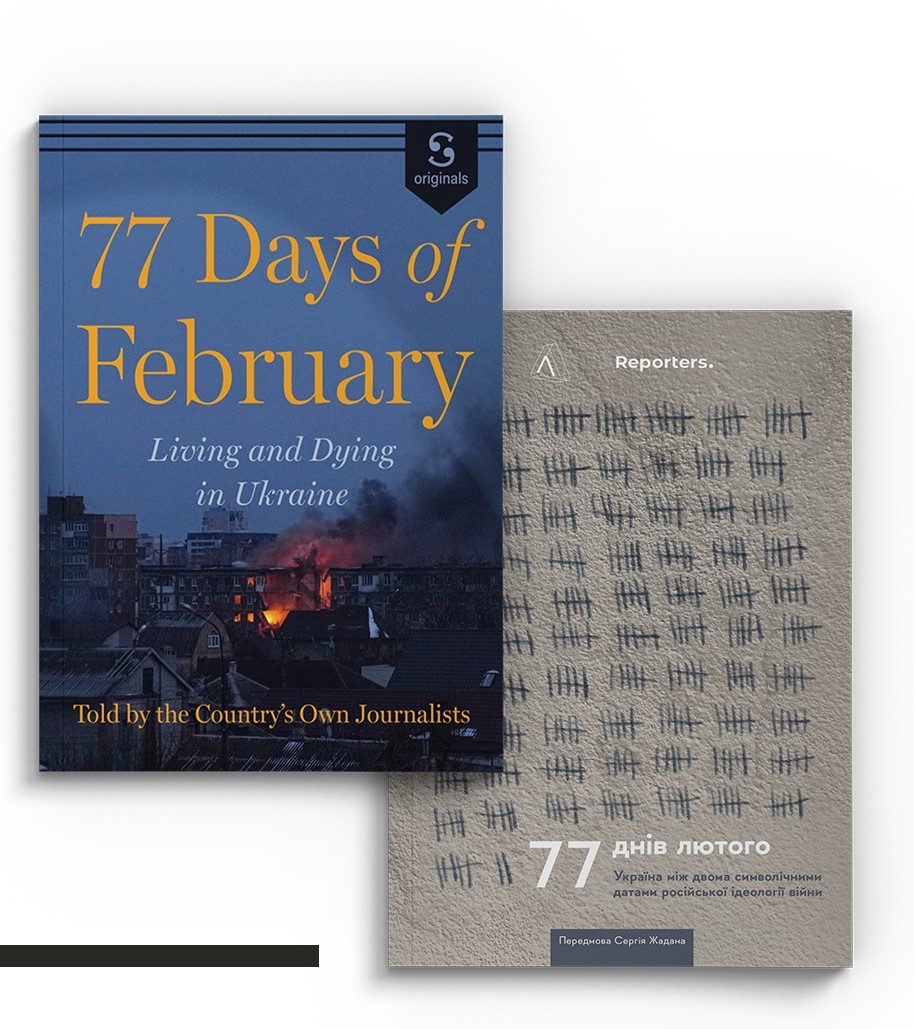* ESC - закрити вікно пошуку
Chytomo Picks
‘77 days’: Capturing the human stories of Russia’s war on Ukraine
22.11.2023
This month in Mykhailivska Square, central Kyiv, a distant train whistle can be heard at night, despite the absence of a nearby station. This sound is part of the popular display of artifacts of the war that famously includes remnants of Russian tanks. The exhibit now features a train car with bullet holes, a vestige of when Russian troops fired on it while evacuating civilians from Irpin in Spring 2022.
No one was hurt in that attack, and while the train had to stop, the crew eventually completed their mission, according to reporting from Ukrainska Pravda. Other evacuation attempts from Irpin did not end so happily. On March 6, 2022, Russians shelled a column of fleeing civilian vehicles fleeing the city, killing eight people.
Recently, as I walked past the train car display, I was reminded of three pieces of literary journalism from the collection “77 Days,” a compelling anthology by contributors to Reporters, a Ukrainian platform for longform journalism. The book, published in English as both an e-book and an audiobook by Scribe Originals, includes two pieces that capture the crucial role trains played in evacuating civilians during the early stages of the full-scale invasion. Anya Semenyuk’s “Trains Packed with Broken Hearts” and Svitlana Oslavska’s “Palianytsia-Ukrzaliznytsia” while a third, Tetiana Bezruk’s “There Were Four People There. Only the Mother Survived.” documents a terrifying flight from Irpin. With its mix of diary-style entries, prose poems, vignettes, and in-depth features, all done with artful prose translated by Dmytro Kyyan and Kate Tsurkan, “77 Days” stands as a testament to why it is necessary to read and follow Ukrainian journalists to understand the human impact of Russia’s war on Ukraine.

“Our reporters were in different parts of the country, and each of them suddenly became the protagonist of their own stories — because every Ukrainian was living through an experience of war that they really didn’t want to have. That’s why these stories are so emotional and vivid — because we wrote them not from the words of others, but from our own deep understanding and feeling of this experience,” explained Reporters editor Marichka Paplauskaite in an interview with Chytomo.
“77 Days” offers a tapestry of styles and experiences from over a dozen contributors, making it a complex work to define. It includes narratives about those who stayed put as the Russians advanced, and the horror they encountered, like Zoya Kramchenko’s defiant “Kherson is Ukraine,” Vira Kuryko’s somber “Ten Days in Chernihiv,” and Inna Adruh’s wry “I Can’t Leave—I’ve Got Twenty Cats.” The collection also explores the ordeal of fleeing, as in Kateryna Babkina’s stark “Surviving Teleportation ” and the aforementioned “There Were Four People There. Only the Mother Survived.”
It also highlights tales of Ukrainians who created safe havens amidst the turmoil, such as Olga Omelyanchuk’s “Hippo and the Team,” about zookeepers safeguarding animals in an occupied private zoo near Kyiv, and one of Paplauskaite’s three pieces, “Les Kurbas Theater Military Hostel,” depicting an historic Lviv theater turned shelter for the displaced, including the writer/editor herself.
The collection also includes tales of heroism and rescue, like Omelyanchuk’s “Pasha and the Old Man,” detailing a daring mission of a sapper with the Come Back Alive Foundation to save an elderly man, Vovo, trapped in an apartment amidst intense fighting in Irpin. Another notable story on this theme is Paplauskaite’s “The Sea,” which recounts the courage of fishermen on the “Kyiv Sea” — a vast reservoir on the Dnieper River. Braving icy waters and the threat of artillery fire, they managed to evacuate around 2,000 civilians from the occupied riverbank.
While the above list is not exhaustive, all 25 pieces in “77 Days” follow the principles of literary journalism, inline with Reporters’s mission. “We have focused on significant social processes and told them through the stories of individuals and the lens of human experience. Our format is a blend of literary reporting and non-fiction, straddling the line between journalism and literature. We’ve written extensively about the war in eastern Ukraine, which has been going on since 2014. But when the full-scale invasion began, we had no choice but to capture the experience,” Paplauskaite explained.
Paplauskaite highlights that despite its somber theme, “77 Days” focuses on the lives of ordinary people, encompassing moments of warmth and humor.
At the same time, I would like to add that there’s no need to be afraid of this book. Yes, most of the stories can be painful, because that’s what war is. But war also brings out the bright and humane side of people. And in our stories that light is present, giving us faith in humanity despite all the tragedies
Trains as shelter and escape
To return to the scene of the train on display at Mykhailivska Square that began this review, the authors of the two pieces focused on train evacuations help capture the deeply personal natute of the writing that helps make “77 Days” such an important work.
In “Trains Packed with Broken Hearts,” Semenyuk sketches the chaotic and emotional moments at a train station in Uzhhorod, when during early March 2022, volunteers prepared hot tea and coffee for displaced people fleeing eastern Ukraine and other regions under shelling and bombing.
Semenyuk vividly recalls the harrowing atmosphere at Uzhhorod train station during the early days of the Russian invasion in her interview with Chytomo. “I remember clearly the feelings – a lot of pain and tears everywhere, a lot of destroyed lives, totally heartbreaking atmosphere. And the train station in Uzhhorod was like the first place where all these refugees come from shelling. They were leaving their houses and their previous lives only with one bag in hand,” she recounted.
Semenyuk continued:
At one of those days, I brought my camera to the train station. As a journalist, I couldn’t take pictures in the first days after the Russian full-scale invasion. I was focused on helping people with little things like tea, coffee, and hugs, and guiding them on where to go and what to do… There was a really heavy pain in the air. When I finally picked up my camera, I felt this pain with my whole body and soul. I realized that all the trains coming to Uzhhorod station those days were full of broken hearts. Ukrzaliznytsia trains were working as life-saving trains. Uzhhorod was not under shelling, but it was bursting with emotions.
For “Palianytsia-Ukrzaliznytsia,” writer Svitlana Oslavska spent time aboard one of those trains, telling the stories of the crew and passengers. In prose that is both understood and poignant, Oslavska describes the anguish conductors felt when having to choose who to take and who to leave behind on the platform, or how passengers, “helped calm other people’s children when their mothers were too exhausted.”

For Oslavska, the immediacy of the events captured in “77 Days” is part of what gives the book its power.
This book is important, a collection of voices of Ukrainians who are writing and thinking about what is happening around them at the moment when it is happening. Since we are talking about the first 77 Days of the full-scale invasion, this means we don’t have this distance that we have today. And those texts, they are a document not only of what happen in Ukraine but also how journalists and in general authors perceived the situation they were inside — how they tried to understand it and how they tried to describe it.
Zhadan struck a similar chord in his introduction “Witness and Remember,” a reflection on the role of language and personal testimony during the war, which also captures part of what will make “77 Days” a reference point for historians and others in the future who want to better understand how Russia’s full-scale invasion of Ukraine was lived and felt by the Ukrainians who experienced it.
These accounts were recorded by some of Ukraine’s finest journalists, who write of their own experience or that of others they met during those harrowing first days of the war. The reports from these eyewitnesses is one more reminder that language is vulnerable but by no means powerless. It builds in our lungs; it needs an outlet. It has enough strength to break out, even under the most agonizing and sad circumstances.
The publication is a part of the “Chytomo Picks: New Books from Ukraine” project. The materials have been prepared with the assistance of the Ukrainian Book Institute at the expense of the state budget. The author’s opinion may not coincide with the official position of the Ukrainian Book Institute.
This publication is sponsored by the Chytomo’s Patreon community
що більше читаєш – то ширші можливості

1112
Chytomo Picks
Time, the evil genius, in ‘Forgottenness’ by Tanja Maljartschuk
20.02.2024 - Anastasia Herasymova
867
Chytomo Picks
Ostap Slyvynsky`s poetry book: a shared space which we can all inhabit
24.11.2023 - Victoria Feshchuk, Yevheniia Sapozhnykova


